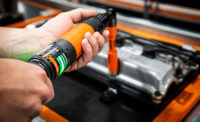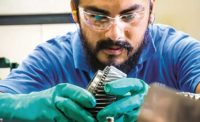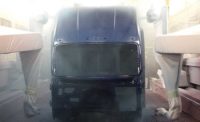Before the availability of electric lights, early automobiles were equipped with gas lamps for headlights and oil lamps for taillights. Electric lights did not become commonplace until the 1920s.
These days, drivers have myriad options for interior and exterior lighting. Whether incandescent, fluorescent or LEDs, modern lighting options can improve safety, add functionality, elevate mood, or simply give drivers the opportunity to personalize their vehicles.
Grote Industries of Madison, IN, has been at the forefront of vehicular lighting for more than a century. Founded in 1901 by entrepreneur William Grote (pronounced grō-tē), the company designs and manufactures LED, fluorescent and incandescent lamps; mirrors; wiring systems; connection accessories; and reflective accessories. Produced for both OEMs and the aftermarket, the company’s products can be found on semi-tractors and trailers, cars, buses, industrial vehicles, recreational vehicles and agricultural machinery.
Still a family-owned business—company president Dominic Grote is the great-grandson of the founder—Grote Industries employs some 1,680 people worldwide, including more than 424 full-time workers in Indiana.
In June, Grote was named a “Great Place to Work” by the Great Place to Work Institute, a global people analytics and consulting firm that helps companies of all sizes produce better business results by focusing on the work experience for every employee. The company earned this credential based on extensive ratings provided by its employees in anonymous surveys. More than 75 percent of the company’s workforce consider it a great workplace.
Not surprisingly then, Grote’s workers tend to stick around. On average, employees have been with the company for 18 years. Tom Blades, Grote’s vice president of operations, marked his 31st anniversary with the company back in January. Recently, we sat down with him to talk about lean, lighting and staying competitive.
ASSEMBLY: Grote is officially a “Great Place to Work.” Does that extend to the shop floor?
Blades: Oh yes. All of our employees were invited to participate in that survey. Pretty much everyone said that they enjoyed working here, that they feel challenged, and that they are recognized for doing a good job.
ASSEMBLY: In 2016, you were named “Executive of the Year” by Ideas America, an international organization dedicated to encouraging employees to become more involved in their workplaces. How does Grote get workers involved?
Blades: We have an ideas program for employees. Everyone except for management is eligible for the program. Employees are encouraged to submit ideas to save time, save money, eliminate waste, or improve productivity. Ideas are referred to committees for the office, warehouse, fabrication and assembly operations. Ideas are reviewed weekly.
If the idea is implemented, and it proves effective, the employee who submitted it will get a small percentage of the savings. In addition, once a quarter, every employee who submits an idea is invited for a nice lunch. Anyone who helps implement the idea is also invited. The goal is to foster a culture of teamwork. During lunch, we review the best ideas from the past quarter, and there’s a raffle for some nice prizes.
One of my jobs is to oversee the ideas program. Not every idea is accepted. In many cases, someone will identify a problem, but will not have the best solution. In those cases, I’ll challenge workers and managers to come up with something better.
A good example involved our packaging and shipping department. One of our products had been packaged in boxes of 12 units each. However, some customers would only buy one or two units at a time, so we would have a lot of partially full boxes on our shelves. That was wasteful. Now, the finished product is stored in boxes of 50, and we ship exactly what each customer wants.
ASSEMBLY: You’ve been with Grote for more than 31 years. What’s changed in that time?
Blades: We’ve adopted lean manufacturing. We’re not a high-volume manufacturer—we’re more like a sophisticated job shop. We supply products to two customer groups: OEMs and the aftermarket. The aftermarket is a high-mix, low-volume business. We have about 25,000 part numbers in our system. With some part numbers, we might sell thousands of units each year. With others, we might sell one. Either way, our aftermarket customers expect us to turn an order around within three days.
After the recession in 2010, we started implementing lean throughout our facility. Our corporate headquarters spans about 450,000 square feet. Believe it or not, back in 2010, we were pressed for space. So we began applying lean techniques to the shop floor, and we were able to free up close to 100,000 square feet just by changing how products flowed and how we ran our shop floor.
Today, our shop floor is pretty much a build-to-order operation for OEM customers. In the first year and a half since implementing lean, we saw productivity improvements ranging from 15 to 200 percent. Incredibly, we hardly spent any capital to do that. We might have spent $20,000.
We’re a union facility, so a big issue with implementing lean was overcoming the fear that people were going to lose their jobs. That was a legitimate concern, because a lot of people did lose jobs during the recession. However, I’m happy to report that no one has lost a job since we implemented lean. Our business is growing. So if a workcell crew goes from five people to three, we have been able to find other jobs for those two people.
ASSEMBLY: In 2014, Grote announced plans to invest $20.7 million in its assembly plant in Madison, IN. What did you do?
Blades: For years, Grote has manufactured wire harnesses and interior and exterior lighting for heavy trucks and semitrailers. But, one thing we haven’t made is headlights. This investment is enabling us to do just that. We are building a 12,000-square-foot “factory within a factory” to produce headlamps for heavy trucks. We’ve invested in a temperature-controlled clean room environment, molding machines and metallizing equipment. We’ll have both fully automatic and semiautomatic assembly lines to produce headlamps on a build-to-order basis. We expect to start trial runs later this year.
ASSEMBLY: Grote was one of the first manufacturers to adopt injection molding machines back in the 1920s. The company likes to be out in front, doesn’t it?
Blades: Yes. We were one of the first manufacturers of vehicle lighting to get into LEDs. Whether it’s automation or robotics, the company has not been afraid to take a chance on new technologies. Frankly, it’s how we’ve secured our growth, especially in the past 15 to 20 years.
ASSEMBLY: Speaking of LEDs, how has the transition from
incandescent lighting to LEDs affected your assembly lines?
Blades: It’s been a huge change. We don’t make the LEDs, but we do make the LED circuit boards for our lights—unlike most of our competition. That has allowed us to control our costs and inventory. It also allows us to be more efficient and responsive. Obviously, it’s a lot cheaper to purchase circuit boards from overseas. However, our competition has to fight supply chain and inventory issues, whereas we do not.
The shift to LEDs has also allowed us to automate more processes. It’s much easier for a robot to insert an LED board in an assembly than to screw in a lightbulb.
Our workforce has had to learn new skills, as well.
ASSEMBLY: What does the future hold?
Blades: Right now, we’re in a good position. We’re growing in the truck and trailer market, and we’re expanding into new markets, including passenger vehicles, off-road vehicles, and marine and aerospace applications. We’re also looking to expand geographically, including China, Europe, Canada and South America. So there are a lot of opportunities for us. We will continue to improve, reduce costs, invest in technology, and apply lean concepts. AGrote Industries makes LED lighting for the interior and exterior of heavy trucks, semi-trailers and other vehicles.








